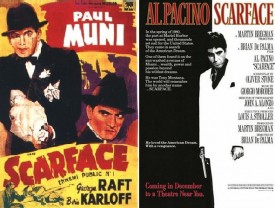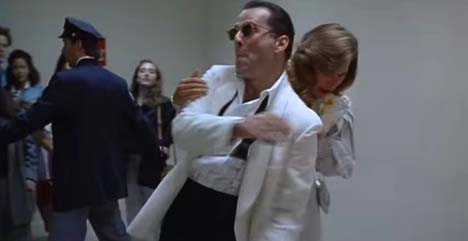SAYING GOODBYE TO THE DISSOLVE
WEBSITE CLOSES AFTER ALMOST TWO YEARS OF TERRIFIC FILM WRITING & DISCUSSION
After almost two years online,
The Dissolve posted a
farewell editorial on July 8, by founder and chief editor
Keith Phipps (today would have marked the site's two-year anniversary). In the editorial, Phipps made it clear there is no one to blame for the shut-down, other than the "various challenges inherent in launching a freestanding website in a crowded publishing environment, financial and otherwise." Here at De Palma a la Mod, we will miss The Dissolve, not just because the site's talented group of writers were consistent proponents of the work of
Brian De Palma, but also for the consistently engaging devotion to cinephilia that bled from the digital pages those writers regularly produced.
Here are some highlights from the De Palma-related articles published by The Dissolve over the past two years:
Passion review by Noel Murray
"With Passion, De Palma is on more familiar ground, using the world of the erotic thriller to note how Skyping, sexting, and tiny pocket cameras are changing behavior, putting everyone in the spotlight and distracting the eye. That’s ultimately what makes Passion a more effective film than the one it’s remaking. While Corneau and Carter were telling a story about what their characters do and don’t see, De Palma is more engaged with what the audience sees. There’s always something to look at in the background of Passion, from the erotic paintings on the walls of Christine’s flat to the video billboards posted around Berlin, and always something eye-catching in what the characters wear, or how they’re posed. The movie is one long game of misdirection, playing tricks on viewers from scene to scene, and showing how easy it is to steer a crowd into missing something important. That’s the real De Palma touch, even more than the operatic overtones and excess."
Scott Tobias interviews Brian De Palma about Passion
The Dissolve: Does it frustrate you as a filmgoer to see the language of a film employed less carefully than that? All that work is elided in a lot of movies.
De Palma: Yes, I would agree. I’m astounded by—whether you’re making a science-fiction movie, a zombie movie, a Star Trek, a Marvel Comics Spider-Man movie—these action sequences that seemingly go on endlessly, without any type of shape or form. So much in action has to do with choreography, and orienting the viewer in where everything is. And I’m amazed all the time that nobody seems to pay much attention to that. So you basically get action and reaction, and it’s like an endless drumming without any shape.
The Dissolve: It seems like they’re trying to make up in sheer, visceral force things that could be done much more elegantly.
De Palma: And obviously, in order to have a crescendo, you have to have some silence. It’s just so simple, but nobody seems to pay much attention to it. They’re basically banging at you constantly. And then in a movie, it’s two hours, too, and then everybody says, “My God, when is this going to be over?” [Laughs.]
Noel Murray's Favorite Scene of 2013: Afternoon Of A Faun, Passion
"Brian De Palma’s Passion starts out as a fairly flat and faithful adaptation of Alain Corneau’s Love Crime, but then after about half an hour, De Palma loosens up and starts making his most visually expressive and delightfully delirious movie since Femme Fatale. In Passion’s best sequence—and one of the best setpieces of De Palma’s formidable career—a ruthless businesswoman played by Rachel McAdams is stalked by a killer on half the screen, while the other half shows her protégée (Noomi Rapace) watching a performance of The Afternoon Of A Faun. The score rises to a peak, and the dancers look directly into the camera, underlining Passion’s theme of misdirection. De Palma keeps pulling viewers’ eyes back and forth, while heightening the tension to the point of distraction. He also calls back to some of his earliest films, like Dionysus In ’69 and Hi, Mom!, where the theater played a central role. Passion isn’t one of De Palma’s top-tier films, but it’s playful and creative, and the Afternoon Of A Faun sequence is a model of how to layer images and move characters with a multiple frames."
Alan Jones investigates why Phantom Of The Paradise was/is Big In Winnipeg
"Regardless, it became a weekly ritual for young Winnipeggers, playing into May of the following year, and encouraging repeat visits. A columnist for the Winnipeg Free Press claimed he had met many people who had seen it 13 or 14 times. 'In many ways, it was almost like a big rock ’n’ roll party for us,' says Carlson. 'At that age, the most subversive thing we might have seen would have been Herbie Goes To Monte Carlo or something.' Perhaps the permissiveness of Winnipeg parents played a role in Phantom’s success, but the film may have also been a generation’s introduction to rock ’n’ roll. For this audience, Williams’ glam rock played as the real thing, their first introduction to 'adult' music, a ripe starting point for a film and musician whose reputation within the city grew with nostalgia and age."
The double vision of Phantom Of The Paradise by Noel Murray
The devil’s bargains and unsparing satire of Phantom Of The Paradise, a discussion by Noel Murray, Keith Phipps, Nathan Rabin, Matt Singer, and Scott Tobias
(Thanks to Drew!)
 In an interview with The Independent's Kaleem Aftab, Al Pacino discusses what Scarface is about, as he sees it. Here's the excerpt:
In an interview with The Independent's Kaleem Aftab, Al Pacino discusses what Scarface is about, as he sees it. Here's the excerpt:



 John Leguizamo will be the guest on the July 14 episode of Dan Rather's The Big Interview, which airs on AXS TV. According to a press release posted at
John Leguizamo will be the guest on the July 14 episode of Dan Rather's The Big Interview, which airs on AXS TV. According to a press release posted at  Michael Rauch, who worked as first assistant director on Dressed To Kill, passed away July 2 following a long battle with pancreatic cancer, according to
Michael Rauch, who worked as first assistant director on Dressed To Kill, passed away July 2 following a long battle with pancreatic cancer, according to  Sorry for the late notice, but Brian De Palma's Phantom Of The Paradise will be screened from DCP at 9:40 tonight at the
Sorry for the late notice, but Brian De Palma's Phantom Of The Paradise will be screened from DCP at 9:40 tonight at the  After almost two years online,
After almost two years online, 
 This new poster for Mission: Impossible Rogue Nation appeared today on sites such as
This new poster for Mission: Impossible Rogue Nation appeared today on sites such as  The
The 